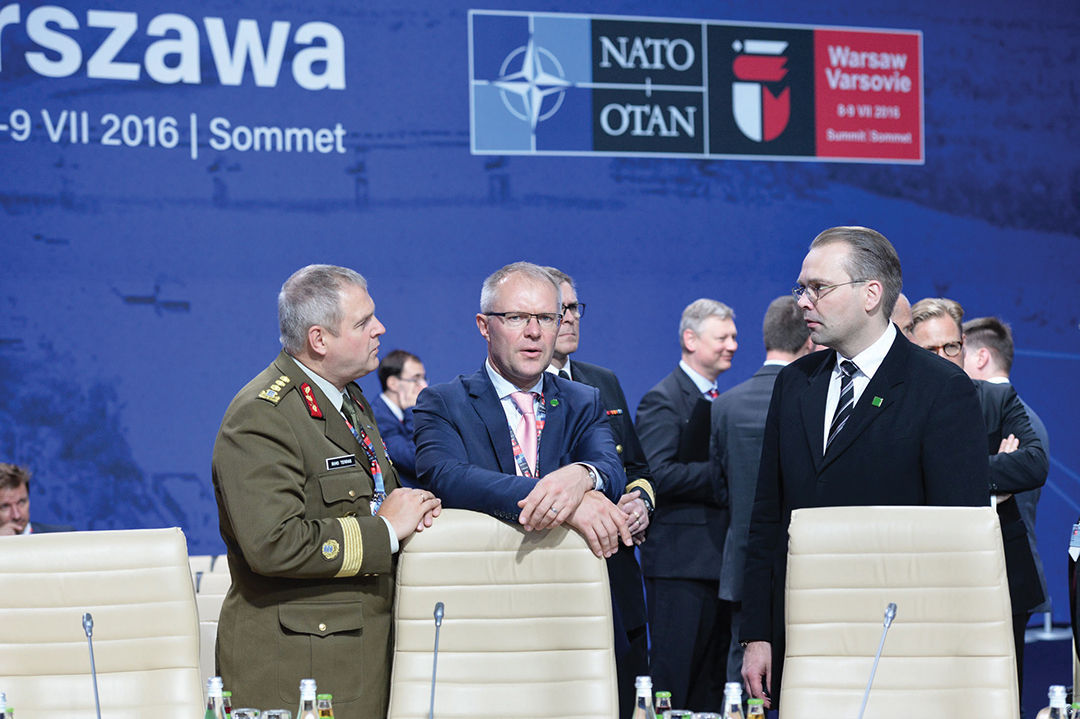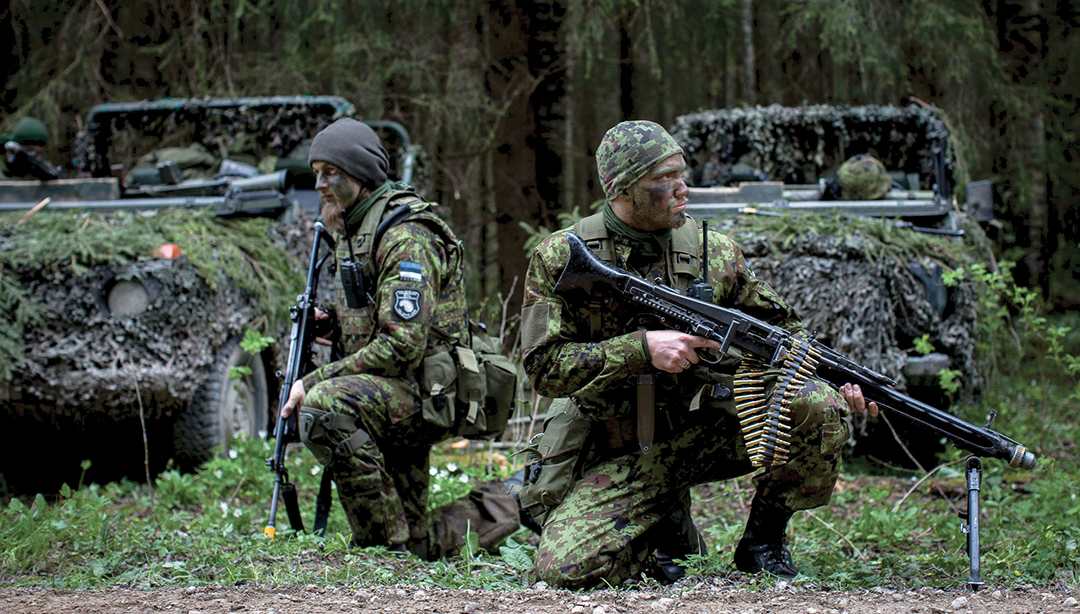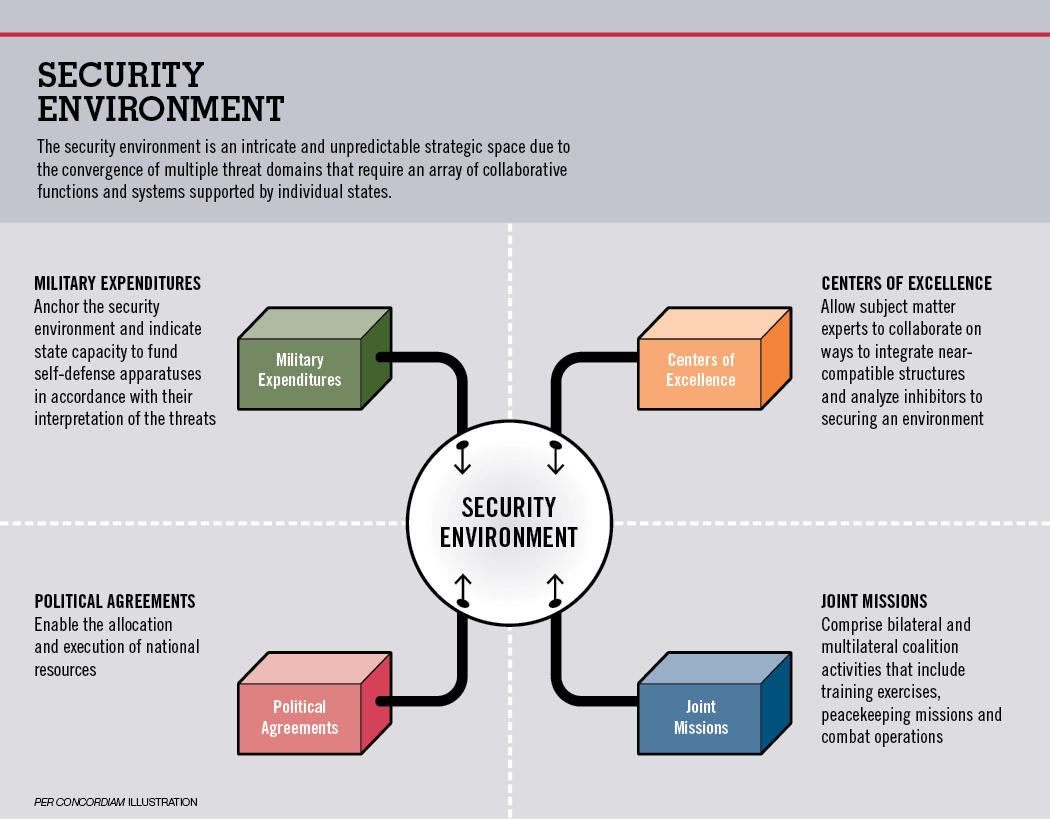A focus on Article 3 would improve interoperability to address horizontal threats
By Maj. Joseph N. Gardner, U.S. Army
In November 2010, at the Lisbon Summit, NATO published a new Strategic Concept that introduced cooperative security as an additional core task. “The Alliance will engage actively to enhance international security,” the document says, “through partnership with relevant countries and other international organizations; by contributing actively to arms control, non-proliferation and disarmament; and by keeping the door to membership in the Alliance open to all European democracies that meet NATO’s standards.” Cooperative security is a long-standing tradition called upon throughout history to institute security measures to protect sovereignty and national interests in the name of stability. In his article “Managing Change: The Reform and Democratic Control of the Security Sector and International Order,” geostrategist Theodore H. Winkler noted: “Every country has, in the security realm, some basic, clearly defined interests, most notably: the ability to protect and, if necessary, defend its territory, air space, sea frontiers, critical infrastructure, and national interests; to guard its borders against illegal and clandestine entry or exit of persons and goods; to safeguard the security, physical safety and the property of its citizens and inhabitants; to protect the country against organized crime, terrorist attack or acts by any sort of group that aims to overthrow through violent means the constitutional order of the existing state structures or to gain control over at least parts of the state territory.”
Cooperative security is the best alternative for regional territorial defense in an environment where a potential adversary’s war machine is superior to those of bordering countries. This imbalance was present during Russia’s military intervention in Georgia in 2008 and its annexation of Ukrainian Crimea in 2014. Moreover, when an adversary wields its dominant power both overtly and covertly, nations with fleeting self-defense tools must rely upon assistance from others.
In addition, the emergence of transregional and transnational threats that affect the stability of a state, its neighbors and states connected by lines of communication, makes cooperation across various security domains paramount. The global commons are held captive today by growing concerns about international terrorism that challenge the dictum of “safe spaces.” Societies face threats that no nation can hope to master acting alone, and opportunities can be more effectively exploited if nations work together. It is necessary to revive, nurture and maintain cooperative security to reassure smaller states and deter larger provocative states. The idea is to demonstrate that inadequate military expenditures create self-defense capability gaps and thus encourage collaboration for NATO’s cooperative security, which is aligned per Article 3.

NATO
Cooperative security concept
Cooperative security is a complex NATO core task that stresses the importance of synchronizing efforts, operating with common standards and sharing critical information pertaining to threat domains. As NATO noted in a communique at its 2016 Warsaw summit: “The complexity and volatility of the security environment underscores the need for a more tailor-made, individual, and flexible approach to make our partnership cooperation more strategic, coherent, and effective.” Extensive writings on cooperative security have tried to codify the term and create dialogue to shape organizational and governmental approaches to the concept. At a time in history when nearly every domain converges in both space and geography, cooperative security must focus on safeguarding civilian populations and preventing territorial instability.
Military expenditures
Acknowledging the disparity in countries’ defense systems, is it sensible to assume that pooling and sharing military resources is feasible to meet the demands of cooperative security? The raw data — only four NATO countries are allocating the requisite 2 percent of their gross domestic products (GDPs) to defense spending — is concerning. Moreover, according to the NATO charter, 20 percent of that 2 percent is supposed to finance major military equipment purchases. As several states struggle to reach the 2 percent threshold and a similar number fail to meet the 20 percent expenditure rate, an even greater concern is that some countries are reducing their overall spending. This decline in defense expenditures was a specific agenda item at NATO’s Wales Summit in 2014, where the Alliance agreed that “allies whose current proportion of GDP spent on defence is below the percent levels will halt any decline in defence expenditure.”
This tells us a number of things. First, if wealthier member states fail to meet the essential minimum, how much harder will it be for countries with weaker economies? Second, achieving cooperative security goals can financially strain — or even break — countries asked to support NATO global operations. This cautionary lesson appears in Azerbaijan’s defense reform review, which notes that “permanent external security must not be established at the cost of damaging the state economy.” Third, and maybe most important, is the reality that many countries’ economic outputs do not allow them to finance military research and development and simultaneously pay decent wages to soldiers being asked to defend their countries and fight abroad. This is especially evident in Central, Southern and Eastern Europe, where many countries are going through security sector reform after the collapse of the Soviet Union and former Yugoslavia, while others are dealing with pockets of regional instability.
Of course, security is the foundation of state stability and the growth of many vital sectors such as public services and economic investment. Even then, it is not quite that simple, because economic development provides the means to finance the security sector and enables a state to allocate that 2 percent. Furthermore, many countries simply do not possess the military industrial base for high-quality research and development, not to mention the mass production capability for technologically advanced military hardware. For these countries, the United States needs to offer cost-efficient options that provide a basic capacity. This inequality of means suggests pooling and sharing is a sound option for NATO.
While pooling and sharing invokes concerns about equitable contributions, the concept is mostly a positive one. For instance, it allows a country to contribute whatever resources it has available to multinational missions. Underwriting peacekeeping and global war on terror missions by deploying personnel serves to help shape the development and execution of NATO action plans.

NATO
Article 3
In many respects, cooperative security nests well within the intent of NATO Article 3: “In order more effectively to achieve the objectives of this Treaty, the Parties, separately and jointly, by means of continuous and effective self-help and mutual aid, will maintain and develop their individual and collective capacity to resist armed attack.” The spirit of cooperative security is for countries to employ their self-defense capabilities in a joint (combined) environment to enhance NATO’s mutual defense against armed aggression. Article 3 outlines what member states and partners should do to mitigate the potential for conflict, whereas when armed aggression happens or is presumed imminent, Article 5 would be invoked, owing to its linkage to collective defense. However, in NATO’s 67-year history, it has only invoked Article 5 once, after the 9/11 terrorist attacks against the U.S. As such, Article 5 has its limitations, because each member state has the right to determine its own response. The essence of Article 5 has always been ambiguity — the word “consultation” in Article 5 acts as an escape hatch for countries.
That is why Article 3’s focus on evolving individual capacity for territorial defense is probably more important for trans-Atlantic defense and security. Though each country sees security through its own lens based on adjacent threats and their threshold for acceptable insecurity, in reality, the security problem can’t be left to individual nations. In this context, states must cooperate either regionally or globally to minimize threats or curtail aggression. “Divide and conquer” is the strategic aim of state and nonstate actors who want to stop the expansion of Western values and norms. Regarding the Baltic states, author Michael Clemmesen notes in his book, Bordering Russia: Theory and Prospects for Europe’s Baltic Rim, that “in the inter-war period, and both before and after the three states regained independence, the Soviet and Russian leadership used the fact that the three states found it difficult to co-ordinate policies to divide and control them.”
In the meantime, the Baltics have worked through many differences and economic competition to gain membership in the European Union and NATO. As noted by German Chancellor Angela Merkel at the end of a Council of the Baltic Sea States meeting: “In times of global competition, regional cooperation can liberate many forces, generating jobs and improving people’s quality of life.” Although each state has internal national interests, partnership demands equal footing with competition for cooperative security to thrive. However, Russia still uses the idea of Russian heritage to keep states such as Armenia, Azerbaijan, Georgia, Moldova and Ukraine off balance. On the other end of the spectrum, nonstate actors are using religious radicalism to nurture a sense of separateness within local communities.
The NATO Warsaw Summit Communique states: “We are continuing to draw on our cooperative security network to enhance political dialogue, to foster constructive relationships in the region, and to increase our support for partners through practical cooperation, as well as defence capacity building and crisis management.” This statement anchors and gives credence to Article 3 being an appropriate impetus for cooperative security. Moreover, political cooperation and productive relations are essential for countries to create self-defense capabilities that overlap and form a mesh-like shield, making the coalition a hard target that discourages armed hostility and thwarts an array of other threats.
 Establishing a durable shield entails the creation of structures and associated doctrine for military operations that support cooperative security. In the post-Cold War world, U.S. Armed Forces are being used as an instrument of American diplomacy to build cooperative relationships with countries that might otherwise be hostile to the U.S. and its interests. Due to the U.S. global contribution to cooperative security and knowing that its forces participate disproportionately in all NATO operations, other NATO members stay attuned to U.S. views. In 2008, the U.S. Department of Defense published an official doctrine that defines and outlines military contributions to cooperative security for execution by geographic combatant commanders and other joint forces commands. It defined cooperative security this way: “The set of continuous, long-term, integrated, comprehensive actions among a broad spectrum of U.S. and international governmental and nongovernment partners that maintains or enhances stability, prevents or mitigates crises, and enables other operations when crises occur.”
Establishing a durable shield entails the creation of structures and associated doctrine for military operations that support cooperative security. In the post-Cold War world, U.S. Armed Forces are being used as an instrument of American diplomacy to build cooperative relationships with countries that might otherwise be hostile to the U.S. and its interests. Due to the U.S. global contribution to cooperative security and knowing that its forces participate disproportionately in all NATO operations, other NATO members stay attuned to U.S. views. In 2008, the U.S. Department of Defense published an official doctrine that defines and outlines military contributions to cooperative security for execution by geographic combatant commanders and other joint forces commands. It defined cooperative security this way: “The set of continuous, long-term, integrated, comprehensive actions among a broad spectrum of U.S. and international governmental and nongovernment partners that maintains or enhances stability, prevents or mitigates crises, and enables other operations when crises occur.”
The U.S. military approach to cooperative security includes five objectives. They crosscut all threat spectrums, but require collaboration with allies and partners. Further, through constant cooperative exchanges with allies and partners, this concept can serve as a solid framework for other nations to build upon and modify according to national interests.
In short, NATO centers of excellence are a fundamental necessity for the progression of interoperability, integration and interdependence; as such, they function equally as pillars of Article 3. By becoming more interoperable through the procurement of NATO standard equipment and implementing principles as detailed in each country’s Membership Action Plan, any member of the Alliance or partner nation can provide continuous and effective mutual aid. Likewise, NATO’s ability to integrate myriad individual state capabilities and advanced technologies will boost collective capacity to enable cooperative security. As for interdependence, it already exists on some levels, since NATO members and partner states rely upon their neighbors in the economic environment for secure lines of communication and shared critical infrastructure. However, the process of operationalizing interdependence to support NATO’s cooperative security concept requires the development of a framework that focuses on future opportunities for operational purposes, opposed to simple near-term requirements.
Much is made of the 2 percent and 20 percent requirements, but output is more important than input. Case in point is that NATO only stipulates what Alliance members should do with 20 percent of their defense allocation; the other 80 percent is spent at the discretion of the state. As pointed out in a 2014 article titled “NATO’s Rebirth: NATO’s New Trajectories after the Wales Summit,” Greece is one of the four countries that contribute 2 and 20 percent, but is not capable and/or is unwilling to project combat power for a sustained period. On the other hand, Denmark, a country that contributes less than the NATO standard, demonstrates regularly that it can and will disproportionately support NATO missions. The best way forward may be a contribution of 10 percent to a NATO research and development fund that takes advantage of collective talent and innovation within the Alliance to yield a projectable and sustainable interoperable NATO warfighting platform.
The aim is to prevent an issue highlighted during the Kosovo campaign, as recognized at the time by then-American Commander Gen. Wesley Clark. “It is sobering to note that over the last decade we witnessed a growing technological gradient rather than a convergence of national capabilities.” This is not to say that NATO as a whole is not better off than it was in 1999. But technology has advanced nearly another two decades, and with NATO expansion, the capability gap remains an inhibitor to seamless operations (real-world and training). As described in an article in The Three Swords magazine: “The difficult task involved with achieving military interoperability is the implementation of a multitude of national policies, procedures, and restrictions designed over years to protect national systems that simply shut the door on interoperability.”
The Way Forward
First, national interests and local priorities require alignment with NATO concepts, since these are the unifying instruments of both soft and hard security. States must recognize that even soft power requires a hard power element to be effective. As such, contributing to territorial defense systems is a crucial aspect of national security. Even if improving the military is a long-term project often sidetracked by other national needs, the act of boosting one self-defense capability reinforces national self-confidence. Expanding regional security cooperation helps identify and share data on potential threats to limit transregional crime.
Second, countries should maintain centers of excellence as conduits for interoperability, integration, interdependence, and information and intelligence sharing. Third, NATO should continue funding reassurance programs for emerging economies; equally, coalition training exercises must remain a priority for stakeholders, even when the countries are not geographically proximate. Lastly, states must recalibrate internal security and defense frameworks to move closer to the spirit of Article 3, since it underpins self-defense and cooperative security. This is not to minimize Article 5, but to accept that states with the capacity and capability to defend themselves help deter aggressive state and nonstate actors. The trans-Atlantic community relies on trust to assure success within security and economic environments, so sharing data, even when it’s not in a state’s best interest, may result in reciprocal assistance that is in the nation’s interest. By sustaining this approach, NATO can continue consolidating the dynamic value of the Alliance and assure the security of Eastern Europe and the South Caucasus.
Conclusion
In the wake of converging threats, states must re-examine internal security to protect their populations. In an operating environment where the fight with the enemy becomes physical today, buying hard security tools tomorrow is too late. Because the world is constantly evolving, rapid advancements in technology and the metamorphosis of threat vectors will not allow NATO to rest on past successes achieved through outdated frameworks.
From an ends, ways and means perspective, the synchronization of the three focal points in this paper can enable full-spectrum cooperative security operations. The “ends” are members’ and partners’ political and security apparatuses aligning with Article 3. The “ways” in which NATO accomplishes this is the exploitation of dynamically innovative centers of excellence. The decisive “means” of warfighting interdependence is the bedrock for cooperative security, which exists through smart military expenditures on the “right” interoperable tools that allow for ease of integration.
NATO’s cooperative security places the Alliance on the right path for continued success moving into 2020 and beyond, but the convergence of transregional and transnational threats requires full adherence by member and partner states to this concept’s principles. Ultimate success in protecting NATO against aggression and an array of threats will depend to a significant extent on how various governments organize to meet this threat.
Maj. Joseph N. Gardner can be reached at joseph.gardner@marshallcenter.org
NATO Threats Matrix
Cooperative Security: Article 3
- Economic and social threats, including poverty, infectious disease and environmental degradation
- Interstate conflict (within Europe)
- Internal conflict, including civil war, genocide and other large-scale atrocities
- Nuclear, radiological, chemical and biological weapons
- Terrorism
- Transnational organized crime
- Cyber network attacks
Collective Defense: Article 5
- Interstate conflict (aggressor outside Europe)
- Russian aggression (east and south)
- Use of weapons of mass destruction
- Hybrid warfare
- Cyber warfare
- Terrorism


Comments are closed.